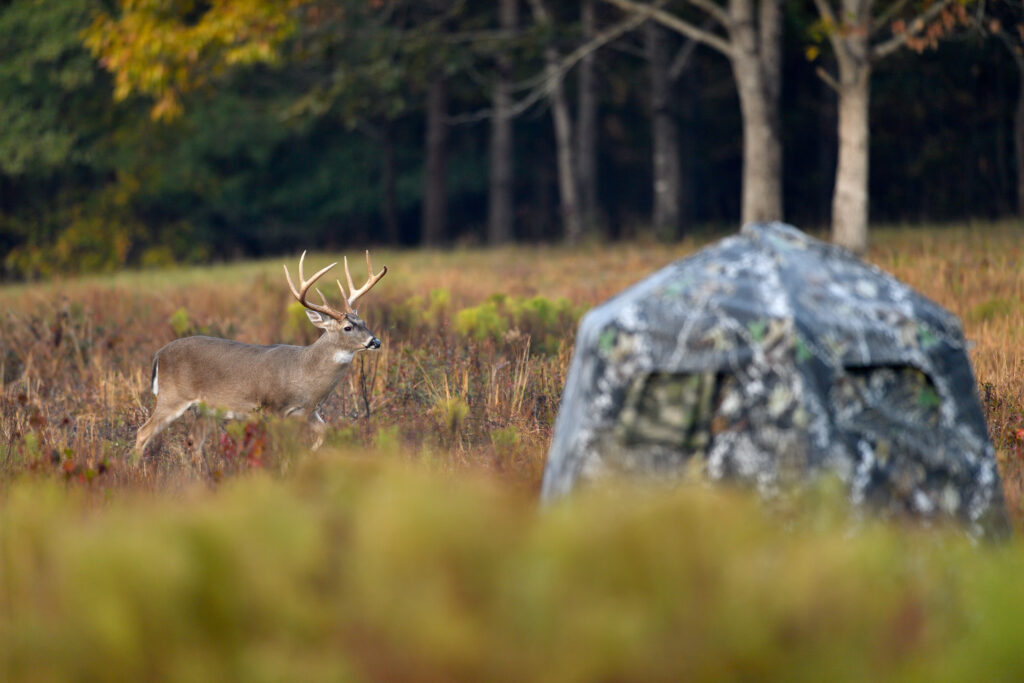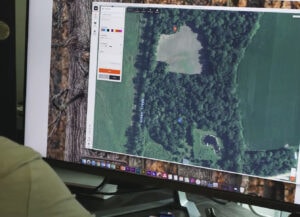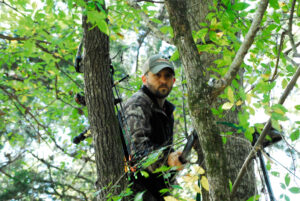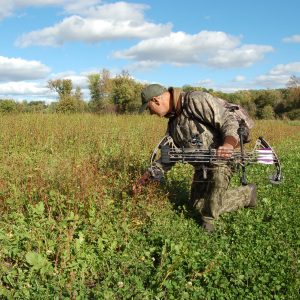Every situation is different and there aren’t any rules where there aren’t exceptions to them. However, over the years I’ve picked up some general practices that will help in most situations when choosing a deer stand placement.

Tes Jolly
Using Travel Corridors for Deer Stand Placement
If you’re an angler, you know about fishing around “structure.” In this context, “structure” is simply stuff that fish or animals relate to. You want to find the “spot on the spot,” that something different that draws and holds fish near. I would argue that whitetails relate to structure more than fish and much of choosing the proper stand site has to do with this. As with most animals, whitetails travel from place to place using cover and terrain to their advantage. Learning to recognize the transition areas, access points, and travel corridors of whitetails is a key to positioning yourself within the area for a shot opportunity.
Almost all of my experience comes from bowhunting. However, I believe that gun hunters would also benefit by applying some of the same principles. With rifles, obviously there is a huge distance divergence from what archery equipment can do. So in this case, sometimes the best spot might be where you can cover the most ground. But still, a long line of sight doesn’t do you any good if whitetails aren’t traveling there. So two of the most important factors are “learning the whitetails’ travel patterns and behavior characteristics,” and becoming skilled at “playing the wind and thermal current.” Learn what type of structure whitetails like and under what conditions they will favor utilizing the site.
Study the Maps
 One of the first things you should do when approaching a new spot is to view a satellite image or aerial photo, in addition to a topographical map. The first spots I would look for are funnels. No matter where you hunt; big timber, agricultural land or suburban lots – there are funnels in your hunting area. With a funnel, their movement is limited to fewer choices so you usually have more traffic converging on the spot. Another very important point is; with movement restricted to a smaller zone it’s easier to position yourself within that zone to remain undetected from their “nose.”
One of the first things you should do when approaching a new spot is to view a satellite image or aerial photo, in addition to a topographical map. The first spots I would look for are funnels. No matter where you hunt; big timber, agricultural land or suburban lots – there are funnels in your hunting area. With a funnel, their movement is limited to fewer choices so you usually have more traffic converging on the spot. Another very important point is; with movement restricted to a smaller zone it’s easier to position yourself within that zone to remain undetected from their “nose.”
I like to use either the satellite image or aerial photo in conjunction with a topographical map. It’s often difficult to see terrain breaks on a satellite image unless the sun is at a severe angle, but the topographical map will point out accurate elevations.
Funnels aren’t always created by two obvious obstructions. Oftentimes they’re created by subtle terrain changes that guide, or force movement one way or another and most often these terrain changes can’t be seen on a picture taken from above, so the topo map can be valuable.
The best way I can explain it is obviously seen if you’ve been around cattle or other domesticated ungulates. Let’s say you put 20 head of cattle in an 80-acre pasture that has never had live stock in it before. There are no trees and only an 8 to 10-foot elevation change in the rolling topography. If you come back a few weeks later, you will see well-worn trails into the dirt going to and from the major attractions in the pasture. Why there? Why not 5 feet to the right or left? It may be the grade, the footing, or some other purpose, but whether it’s for safety or energy conservation, there is a reason they’re traveling in that spot. Whitetails are no different, in fact, they’re experts at energy conservation. They want to take the easiest, safest and least conspicuous route between two points…unless they’re fleeing danger.
When looking over an area, imagine it first without any trees, brush or blow-downs. Look for the points, topography breaks, steeper angles, edges or turns that will force or encourage the animal to go one way over another. If you try and foretell their travel patterns this way first, when you add the trees, brush, blow-downs and other physical obstructions back to the picture it can sometimes seem obvious where they will pass through.
Using these same ideas, why not influence whitetails to travel where you want? It’s possible to create your own trails by using a pruner through brush or a weed-whacker through tall grass and weeds. Mature bucks can often be found around the thickest, nastiest cover you can find. However, when traveling through the thick cover they will almost always, unless forced, travel the easiest route they can find – the path of least resistance. You can also fell trees to force them to go a certain direction. Create your own “man-made” funnels.
Consider Air Current Patters When Placing a Deer Stand
Knowing a whitetail’s number one defense is its extremely responsive sense of smell, to experience consistent success we need to learn how to battle it and maybe even use it to our advantage. Aside from reducing odors on our person and cutting down on the foreign odors we leave behind, we also need to understand how whitetails use the air currents to their advantage. In addition to “playing the wind,” you have to “play how the whitetails play the wind.”
It all starts with a good scent elimination regime. We need to reduce foreign odors to a minimum. Everything that I bring into the whitetail’s domain will be treated with the Scent Killer system to destroy smells at the molecular level. I prefer Scent Killer Gold Spray, because of its “Hunt Dry” technology it can be sprayed on your hunting clothes and will work for days after drying.
Besides reducing offensive odors, we also have to learn how to deal with the wind and thermal current. You have to know how to place yourself within their terrain so you can “see them” before they “smell you.” Learning air current patterns is also a vital to predicting whitetail movement.
Everybody knows what the wind is, but most whitetail hunters east of the Mississippi don’t pay close enough attention to thermal current. The heating and cooling of the air combined with different temperatures emanating from various sources makes the air current do some strange things. In the west, because of the mountainous topography most veteran hunters are familiar with thermal, but it’s also important in flat areas too. It could be as simple as when hunting a clearing and paying attention to where the sun will rise. When the sun comes up it shines on one side of the clearing first. The sun warms the air and the current begins to rise on that side of the clearing before it does anywhere else.
Pay particular attention around water, rocks, dark conifer trees or anything that may retain a different temperature than the air. When the temperatures differ, you’d be amazed at how the air current may be swirling around.
Then we come to possibly the most important detail, trying to understand “how whitetails play the wind.” Many mediocre hunters lick their finger, stick it in the air, and point downwind to the spot where they’ll place their ambush. Here’s where they fail – often the sign they are setting up on has been made under totally different conditions than the wind blowing that one particular direction. It’s good that they realize to be fairly consistent you want to try and remain downwind or crosswind of their powerful olfactory advantage whenever possible. A whitetail will not spend a great deal of time in an area where it can’t use its sense of smell efficiently. A buck may never use a trail or enter an area under certain conditions.
You can’t simply set up downwind of an area and think “they won’t smell me here,” and expect to have consistent success. My first thought about a spot is “under what conditions will a whitetail want to be in this area.” I want a buck to feel comfortable with the chosen site, but also under the conditions that I want to hunt the site. You need to set up for “how a whitetail plays the wind.”
My best advice is to purchase some sort of wind-detection device, or next time you walk past some cattails grab some duff, or some milkweed collect some seed. Milkweed seed is my favorite “wind-checker.” This way you can actually see how the air current is blowing. Aside from being a great tool to physically play the wind, when you actually see the air current it really helps to teach you some of the secrets of deer movement.
Improvise, Adapt and Modify Your Area
 Sometimes it’s possible to add features to an ambush location to make shot opportunities come much easier. Above, we hit on using felled trees sort of like a fence, to guide or restrict movement, but there are a number of things we can do to enhance a site. Planting food plots or mast trees, removing or adding licking branches to an area when scrapes begin to be utilized, creating sign posts with urine-based scents, or by cutting easily traversable trails for them to use – these can all change the travel pattern to favor your ambush location.
Sometimes it’s possible to add features to an ambush location to make shot opportunities come much easier. Above, we hit on using felled trees sort of like a fence, to guide or restrict movement, but there are a number of things we can do to enhance a site. Planting food plots or mast trees, removing or adding licking branches to an area when scrapes begin to be utilized, creating sign posts with urine-based scents, or by cutting easily traversable trails for them to use – these can all change the travel pattern to favor your ambush location.
It may be advised once you find a good spot to set up multiple stand locations so that you can play different wind directions and conditions, yet hunt the same deer. At a given time, I may have as many as a dozen different stand locations to pursue one specific buck. This way you won’t burn a stand and ruin your chances at a mature buck by pushing your luck and hunting a site when the conditions aren’t in your favor, which is NEVER a good idea.
How close do you set up to a bedding spot? This is an impossible question to answer. Every buck should be vulnerable at some point. It’s up to you, through scouting to learn where that will be. The closer you get to a bedding area, the better your chances for a shot during legal hunting light – whether returning in the morning after a night feeding or chasing the ladies, or in the afternoon on his way out to do it all again. However, getting “too close” can ruin the entire hunt. The last thing you want to do it alert the buck to the fact he’s being hunted.
When to Set up Your Deer Stand
A topic of contention is whether or not you need to have a treestand or ground blind in place well in advance of the hunt so the animals can become accustomed to it, or can you hunt it the same day? I prefer to set up stands or blinds well in advance of hunting them, but I have to admit that I’ve also seen success out of blinds/stands that I set up directly before hunting them, and hadn’t even taken the time to “brush it in” to the surroundings.
If building/erecting a box blind or shooting houses, I think it’s wise to hunt the location several times out of a portable treestand or ground blind first, before you erect something you’re NOT going to want to move if you have it wrong. If putting a more permanent structure in place, make sure you know the travel patterns FIRST.
Possibly one of the most important details is that you hunt the spot only when the conditions favor you. It’s rare that all the stars align for the perfect conditions to hunt a spot, but we need to at least make sure the air current favors our position and that we can approach and regress from the area without alerting animals.
More bucks are harvested each year while hunting from treestands than by any other method, however, ground blinds are also extremely effective. If you examine the site’s topography and structure, take the time to learn the herd’s travel patterns and then take the wind and thermal into consideration, success will come for you.






